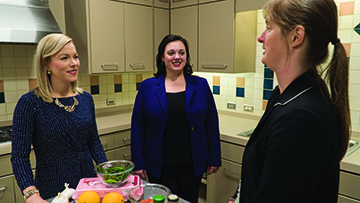
Studies estimate that 13.1 million children in the United States live in households that lack secure access to nutritionally adequate and safe foods; at the same time, 62 million metric tons of food are wasted each year in the United States. In light of this, students and faculty in Samford University’s School of Public Health partnered with the United Way of Central Alabama and Community Foundation of Greater Birmingham to create a toolkit that could equip local organizations to evaluate their summer feeding programs and reduce waste.
Dietetic interns Danielle Russell and April Punko worked under the supervision of public health faculty Rachel Casiday and Kim Davey, and Department of Nutrition and Dietetics assistant professor Katie Coate to conduct an evaluation and plate waste study at three summer feeding programs in the Birmingham area.
They evaluated programs at Blount County Schools, Alabaster City Schools and Greater Birmingham Ministries during the summer of 2016, and plan to continue the study at New Rising Star and Community Food Bank of Central Alabama during the summer of 2017. Each of the summer feeding programs offered meals to children under the age of 18 who typically receive subsidized meals during the school year.
One component of their evaluation of the summer feeding programs was a plate waste study, designed to determine how much food is being wasted versus how much food is being eaten.
While the study did gather quantitative data, its main purpose was to establish a methodology that organizations could use to better evaluate their summer feeding programs. At the study’s completion, Casiday hopes to present the United Way of Central Alabama, Community Foundation of Greater Birmingham and their partnering organizations with a toolkit they can use as a reference to reduce food waste while not compromising the quality of the food they serve.
Several elements are taken into consideration. For example, the toolkit will provide alternative ways to measure food waste that do not require expensive equipment, which is helpful to new or nonprofit organizations.
To gather information, Russell, Punko, Casiday, Davey and Coate collected data, interviewed program participants, weighed plates and assisted with the analysis. Russell focused on analyzing the Food Research and Action Center standards for summer food programs, and developed worksheets that included prompts, questions, rubrics and metrics for organizations to use in measuring plate waste. She then tested the worksheets by using them to gather data at the program sites. Punko ran all the mathematical and statistics results gathered in Russell’s worksheets.
Following the evaluations last summer, the team was impressed with the summer feeding programs available in the Birmingham community.
“My favorite part of the project was getting to see each of the program sites,” said Russell. “Each one was unique, and they were all doing their best to serve the kids and families in their communities.”
Russell explained that some sites offered cold sandwiches and craft projects each day. Others served hot lunches with varying vegetables and entrees along with nutritional education classes. Each site varied as far as food and services based on its available staff and funding.
“I am so impressed by the work and dedication of the people who have set up these programs,” Casiday said. “There is a desire to do something that is important for the community and the children of the community. We all want to make sure the kids in our community get fed in a way that is healthy for them.”
Olivia Odom is a journalism and mass communication major and news and feature writer in the Division of Marketing and Communication.
